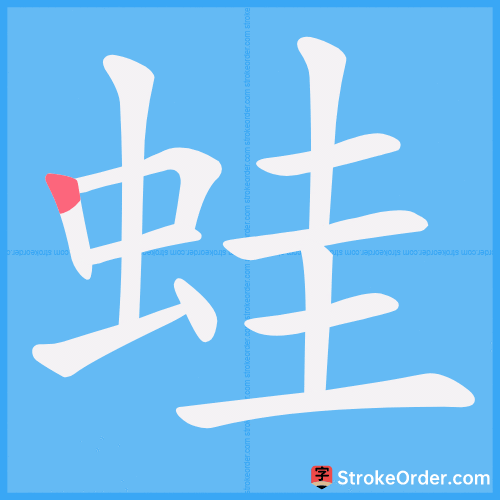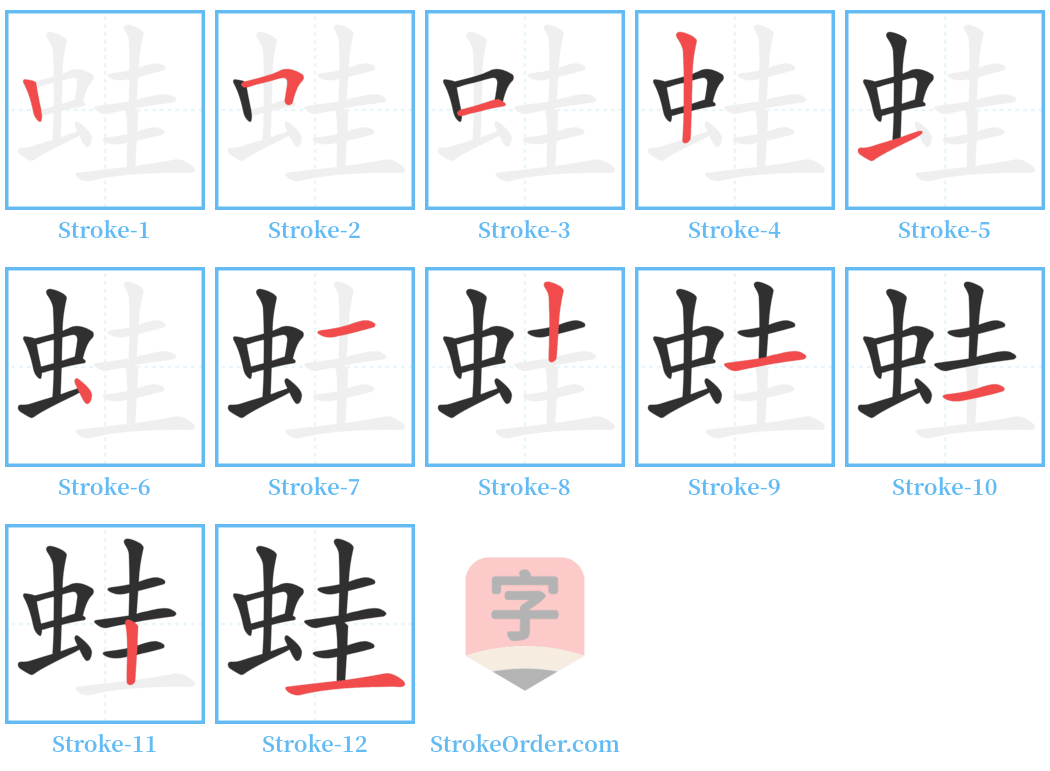蛙 Stroke Order
Animated Stroke Order of 蛙

Stroke Order Diagrams for 蛙

Step-by-Step Handwriting Guide for 蛙

Learn to Write Chinese Characters with Video Tutorials
Watch the video of writing the Chinese character "蛙", learn the correct stroke order (笔顺) of the character "蛙", and master the standard way of writing the character "蛙".
Free Printable Handwriting Practice with Stroke Order: 蛙
Printable Writing Practice Worksheet of "蛙" in Portrait Orientation (Tian Zi Ge)

Printable Writing Practice Worksheet of "蛙" in Landscape Orientation (Tian Zi Ge)

Information of 蛙
Pinyin
wā
Radical
虫
Strokes
12 strokes
Usage
★★★★★
Definition
frog
蛙 [wā]
名词
1. A family of amphibians classified by having no tail, long hind limbs, short forelimbs, webbed toes, and being adept at jumping and swimming. There are many species.
(English: A family of amphibians known for having no tail, long hind limbs, short forelimbs, webbed toes, and proficiency in jumping and swimming. Many species exist.)
- Example species: 青蛙 (commonly known as "rice paddy frog"), 牛蛙 (bullfrog), 蛙泳 (frog swimming), 蛙人 (frogman).
引
1. In "Shuōwén Jiězì," it is noted that common people refer to it as 田鸡, and in Yangzhou, it is called 水鸡, also known as 吠蛤.
2. From Song Dynasty poet Xin Qiji's poem "Xijiangyue · Night Travel on Huangsha Road": "Hearing the calls of frogs all around."
例
- Example usages: 蛙市 (Frog market - nighttime gathering of frogs croaking); 蛙吹 (Frog croak); 蛙角 (Hairstyle resembling the symmetrical protruding parts of a frog's head); 蛙怒 (Describing the loud croaking of a frog, akin to an inflated rage); 蛙蛤 (a type of frog).
形容词
1. 淫邪 (English: licentious).
- Example usage: 蛙咬 (licentious music); 蛙声 (lewd sounds, licentious music); 蛙歌 (lewd singing).
2. 凹隐 (English: low-lying) – With a sullen look.
- Example reference: In "Jin Ping Mei," it describes a character who keeps a sullen face and does not speak.
Input Method for 蛙
Pinyin
wa1
Wubi
jffg
Cangjie
ligg
Zhengma
ibb
Four Corner
54114
Unicode
U+86d9
Same Pronunciation Characters